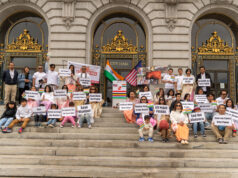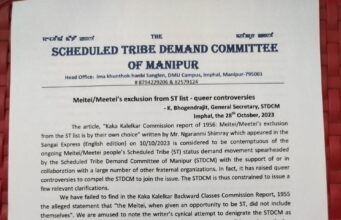Two-Day National Seminar
on
Ethnic Relation in Manipur: Past, Present and Future
(September 13- 14, 2014)
Kangla Hall, Imphal
jointly organized by:
National Research Centre, Manipur
& State Council of Educational Research and Training, Manipur
Press Release
A Two-Day National Seminar on “Ethnic Relation in Manipur: Past, Present and Future” was held on September 13- 14, 2014 at Kangla Hall, Imphal. The seminar was jointly organized by the National Research Centre, Manipur and the State Council of Educational Research and Training, Manipur.
In the Opening Ceremony of the seminar, Shri Aheibam Rommel, Prof. V.E. & Head of Office, SCERT, Manipur was the Chief Guest and Prof. (Red.) MS Ningomba, Founder President, NRC, Manipur presided the function. Shri P. Bandhan, Secretay, NRC delivered the Welcome cum Keynote Address. He said that various ethnic communities have co-existed in Manipur since time immemorial. But today, Manipur is a fragmented society with each ethnic group having own aspirations. The main aim of the seminar was to understand how all ethnic groups can work together for a united Manipur by understanding the past and keeping in mind the significance of the future.
Shri Aheibam Rommel said that the Seminar will be followed by a workshop for building up of a better and harmonious relation among the various tribes and communities in Manipur. He shared that SCERT, Manipur also will produce a text book for students on ethnic relations in the state based on the papers of the seminar as well as inputs gathered during the proposed Workshop.
Prof. (Red.) MS Ningomba in his Presidential address stated that one cannot blame the past for what is happening at present. This present will become a past someday, thus, one should always be guided by honesty. He stressed that to bring about a good future of Manipur what is needed is honesty from everyone and ability to work across individual and group interest. This applies to ethnic relations in Manipur
The first academic session was titled “Ethnic Pluralism and Its Significance”.
Prof. Arambam Lokendra, Former Director, AVRC, Manipur University, Canchipur was the Moderator and three Resource Persons presented papers.
RV Mingthing, former MLA presented a paper on “Contemporary Issues faced by Northeast: Need for Collective Action”. He said remarked that adoption of Hinduism and forceful conversion of the general populace into Hinduism by King Charairongba (Pamheiba) including the Puya Mei Thaba of 1732 was an unfortunate incident in history. After he ordered the conversion of all the populace into Hinduism, those who opposed started following different ways of lives. Then he elaborated on the different political aspirations adopted by various ethnic groups in Manipur by undermining history and collective experience and is responsible for fragmentation of the State. He opined that all the states in the Northeast are very small; there is no harm in uniting and forging a united Northeast by retaining each state’s own identity.
Dr. Chirom Rajketan Singh, Assistant Professor of Manipuri, Kha Manipur College, Kakching, presented a paper on “Understanding composite History of Manipur through Oral literature: A Study”. According to Dr. Chirom, there are still today many groups of people who do not yet have a written history. However, these societies have their own oral histories. Even when there are written histories or chronicles, many accounts of history are found in the oral histories even though they are not mentioned in the chronicles as such records are ‘palace-centric.’ The paper was on the study of the oral history of the different communities of Manipur to find out the similarities and trace a commonness in the origin by focusing on the oral history of Tangkhul, Mao, Maram, Thangal, Paomai and Kabui communities. Further he elaborated on the oral tradition of Aimols, Kharam, Chiru, Chothes who also has a similar history saying they once lived in a cave. Their traditional attire, religion and culture bear lot of similarities of those of the Meeteis. He concluded by stating that if one looks into oral histories of various communities in Manipur, all share a common and same origin and is in fact very close to one another.
Dr. H. Shimreingam, Assistant Professor of English, Pettigrew College, Ukhrul presented a paer on “The Cave Born Tribes of Manipur and the Tangkhul Literature”. He dwelled on theory of the Cave Born Tribes and commented on old books of the Tangkhuls that tells that the early Tangkhuls came out of a cave along with Maring, Kabui, Mao, Aimol, Anal, Chothe, Lamkang, Moyon, Monsang, Tarao, Thangal, Maitei (originally the Tangkhuls called Maitei for Meitei and Matei by Hungdung village meaning ‘our people’), etc. The Angom clan of Meitei community traces their origin from Khangkhui Village. Tangkhul Chahong clan is said to have migrated from Meitei and claims the affinity with the Angom clan. He also traces the origin of Moirang Laiharaoba to the Lungka Tangkhul Village. He added that the Tangkhuls claim that the legendary king of Manipur, Pakhangba who ascended the throne of Kangla in 33 A.D. was born of a Tangkhul woman. The Hungdung tradition claims that ruling clan, ‘Mangang clan’ descended from them. He shared a Tangkhul poem which tells the story of a Tangkhul beauty who became Queen of Manipur and brought Tangkhul-Meitei ties through her: In the most immediate recent past, the Tangkhuls said that during ‘Seven Years Devastation’ (1819-1826), a large number of Meitei populace including grown up youths went up to the Tangkhul villages and took refuge there. Some Tangkhul villages still retained the name ‘Khunthak’ (meaning feeding village) say the present Sirārakhong village was also previously called Khunthak for feeding the Meitei refugees.
The post lunch session of the seminar was titled, “Ethnic Relation and Conflict Situation”. The session was Chaired by Prof. N. Joykumar, Department of Political Science, Manipur University, Canchipur. Two Resource Persons presented papers.
Dr. Dhanabir Laishram, Social Scientist based in Manipur spoke on, “Hill-Valley Relationship in Manipur: Past and Present.” He said that what is witnessing in Manipur is bypassing the composite history and symbiotic economic relationship between the hill and valley. He was of the opinion that none of the ethnic communities of Manipur are not spearheading to bring such vexed problems and spiral conflict situation in Manipur. These are the handiworks of external forces like Hinduism, British Colonial rule and big bureaucrats from India who administered the state when Manipur was undergoing political transformations viz. from part ‘C’ State to Territorial Council, and then Union Territory and statehood. Over and above, capitalist system of India with democratic institution without democratic politics is being imposed to upon both hill and valley people. In short, the same administration of British is still being practiced today in Manipur. He recommended that the people of NE should have democratic politics, which shall operate under the rule of law and should be ensured the highest level of internationally recognised human rights and fundamental freedoms. Further, he added that the time-frame for implementation of the peace agreement should not be as short as one year, but perhaps 3-5 years, in order to allow time for national reconciliation and people to people dialogue among the various ethnic groups to lay the foundations of institutions of peace. In reality, the Government should accept that justice can only follow peace. Finally, he concluded by saying that the question of identity should not be associated with territory as it will hamper all the peace talk and accords. And composite dialogue is highly needed instead of piece-meal one.
Dr. Leban Serto, Freelance Consultant for the Berghof Foundation, Germany presented a paper on “Ethnic integration: Community and Peace Building in Manipur”. Dr. Serto stated that there are about 37 recognised tribes along with the Meitei and the Meitei Pangal (Muslims) and of other communities in Manipur. Conflict dynamics and security threats in the present state of Manipur are historical, multi-layered and diverse in nature. Most conflict have identity based conflict, interstate, intra state, communal and armed violence struggles against the existing status quo. He suggested that the leaders must build communities based on the vision of the “Moral Imagination” i.e to look to the future, building constructive transformation of our existing conflicts non-violently and preparedness of an unseen future, with a hope that its members will be contributing members of societies in the fast changing world. He concluded by saying that building a quality and responsive society is vital for ushering in a new era for hope, stability, security, peace and sustainable development progress, ethnic tolerance, integration, respect and a flouring vibrant community in Manipur.











